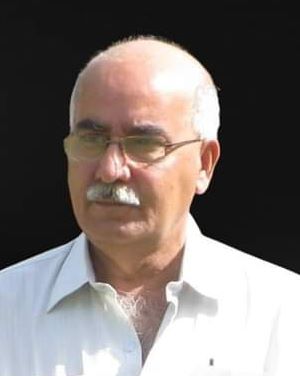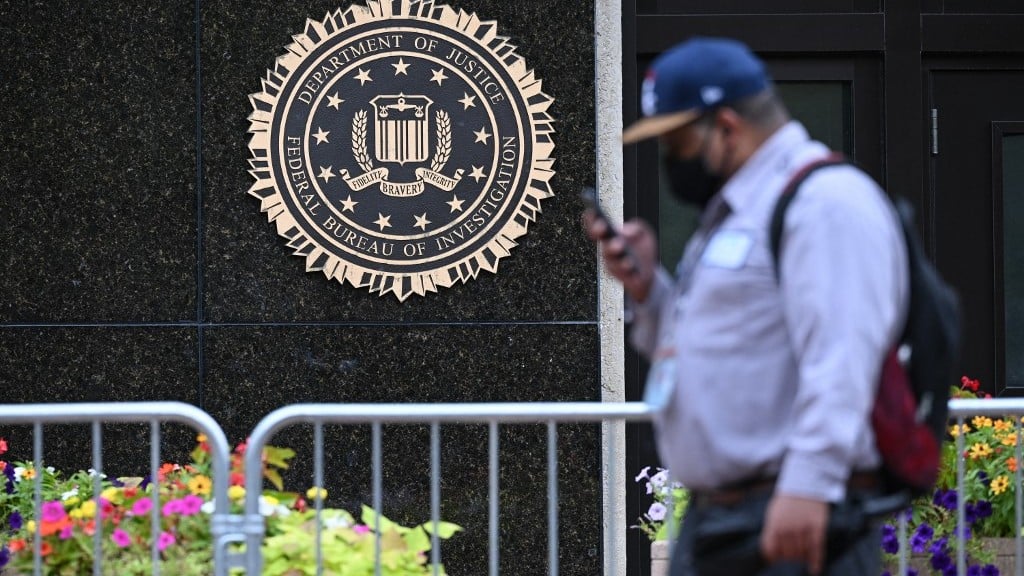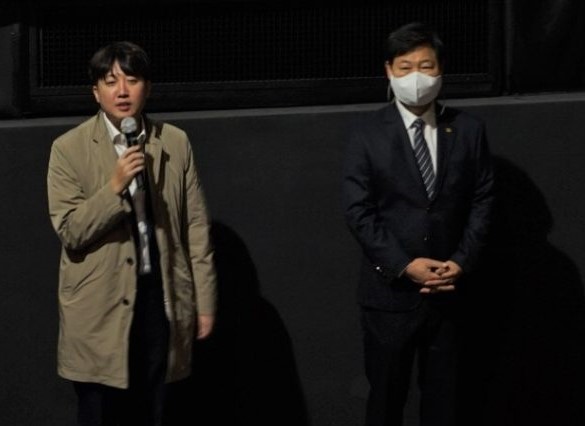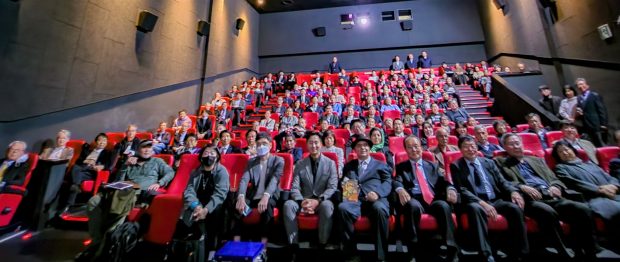The post Congress of African Journalists launches CAJ TV first appeared on Sindh Courier.
]]>Abuja
After the success of CAJ International Magazine; the publication of the Congress of African Journalists (CAJ), CAJ TV begins with messages of its editors.
The Congress of African Journalists (CAJ) is a unique organization for journalists of African descent around the world that aims to protect practitioners of the journalism profession, improve journalistic practice, and create a large network on the African continent and beyond in diaspora. It is headed by Nigerian journalist Michael Adeboboye, an international, independent journalist whose work has been published in international media in the USA, Asia and Africa.
The organization represents a great network for Africa and the rest of the world to share ideas and content for readers without restrictions or language barrier.
Read: Congress of African journalists (CAJ) – a Story to be told
It has extensive coverage of Africa with contributors in over 30 different African countries including the diaspora. Its magazine publishes stories on diverse topics from Africa and beyond. While its channel begins with letters from its editors, it is expected to grow with content that will be a mirror of the culture and civilization of an ancient continent.
Published under the International Cooperation Protocol with Middle East Business
___________________
The post Congress of African Journalists launches CAJ TV first appeared on Sindh Courier.
]]>The post International Cooperation Protocol for Simultaneous Publishing of Articles in Arabic and English first appeared on Sindh Courier.
]]>The writer Mohamed Munir, journalist at Al-Ahram, founder and editor-in-chief of (Middle East Business) and (Life Arabia), which are published in Arabic, English, and Chinese, invited Ashraf Aboul-Yazid, president of the Asian Journalists Association and editor-in-chief of the Arabic edition of the Future News Network (AsiaN), published in Seoul in Korean, English, and Arabic, and the veteran Pakistani journalist Nasir Aijaz, editor-in-chief of Sindh Courier (Sindh Courier), to join a joint protocol that allows writers of the three platforms greater space to interact with readers in Asia, Africa, and the world.
Silk Road of Media

Ashraf Aboul-Yazid stated that the protocol will not only expand the scope of reception but will also represent a new Silk Road of media, with its rich stations through opinion columns and various fields of journalistic writing. The writers of the three websites hail from more than fifty countries. The protocol will be a living table for dialogue and a vision of new ideas, discussing common concerns and proposing new solutions.
Bridge of Knowledge
Nasir Aijaz enthusiastically welcomed the proposal, emphasizing that the proposed mutual publishing initiative will not only expand the reader base but also act as a bridge between countries worldwide, especially Sindh and Pakistan, proving to be a significant source for spreading knowledge about culture, economy, political scenarios, and other life areas in the relevant regions, which were home to great civilizations.

In fact, union journalism allows media institutions from different countries to share their unique perspectives and stories, providing readers with a more diverse and comprehensive understanding of different cultures and tourist destinations. Through content sharing, media institutions can reach a wider audience across various countries, helping to promote cultural exchange and tourism opportunities on a global scale. This initiative will also help us access high-quality content from each other without the need for extensive resources or investments. This collaboration will enhance the sense of a global community and cooperation in promoting cultural understanding. Furthermore, union journalism will strengthen the credibility and accuracy of the information exchanged, helping to promote cultures and tourism in a more trustworthy and reliable manner.
Broader Horizons
Mohamed Munir, founder and editor-in-chief of Middle East Business and Life Arabia, said, “We at (Middle East Business) and (Life Arabia) are proud to collaborate with (AsiaN) and (Sindh Courier) in this international protocol. This partnership will enable us to offer diverse and rich content to our readers in Arabic, English, Chinese, and Korean. We believe that exchanging articles and ideas across these platforms will enrich our readers’ experience and broaden their horizons.

This collaboration is an important step towards building a media bridge connecting different cultures and societies, enhancing understanding and mutual appreciation. We look forward to offering content that addresses the issues and concerns of societies in Asia, Africa, and the world as a whole, focusing on presenting new solutions and perspectives for shared challenges.
We are pleased to be part of this growing media network and look forward to effectively contributing to this initiative that enhances cultural exchange and broadens awareness among different peoples.”
Adding, “This protocol is not just a media collaboration but a platform for exchanging ideas and experiences between multiple cultures. We strive to be a bridge through which readers can cross into new horizons of knowledge and culture. Our goal is to provide content that is deep, diverse, accurate, and reflects multiple viewpoints from around the world. Through this collaboration, we hope to have a positive impact on communities by promoting mutual understanding and highlighting inspiring stories and experiences from different cultures. We look forward to this protocol being a window through which Arab and foreign pens can view the world, contributing to spreading awareness and knowledge. In an era of rapid events and developments, we see this collaboration as an opportunity to provide comprehensive and balanced coverage, reflecting reality in all its dimensions, respecting our readers’ intellects, and enriching their understanding of the world around them.”
New Partnerships
Munir concluded his speech, saying, “We consider this collaboration with (AsiaN) and (Sindh Courier) just the beginning of a new and ambitious phase in our media journey. We look forward to expanding our network by establishing partnerships with major media institutions around the world for joint publishing. Our goal is to create an international media network that contributes to enhancing cultural and knowledge communication between different peoples and cultures. We believe these partnerships will open new horizons for exchanging diverse and rich media content, benefiting all participating parties.
This type of collaboration enhances the chances of providing more comprehensive and diverse media coverage and helps build a deeper and broader understanding of global issues.
Sindh Courier
Sindh Courier, an online news and opinion service, and a non-profit, non-commercial organization, was established five years ago for convergence, especially among writers, poets, and artists from different countries around the world. As a result of this initiative, Sindh Courier (sindhcourier.com) received a positive response and succeeded in developing a network of writers, poets, and artists. It now enjoys a broad readership base in over 50 countries, while writers, poets, and artists from several countries, including China, the United Kingdom, the United States, India, Bangladesh, Italy, Greece, Mexico, Uzbekistan, Nepal, and others, regularly share their works, which are published by Sindh Courier. I would like to specifically mention Ashraf Aboul-Yazid, who not only wrote regularly for Sindh Courier since its inception but also helped connect it with the community of writers and poets in Africa and other continents. In the end, I must thank him and appreciate his tireless efforts.
AsiaN AsiaN
The AsiaN is the media portal of the Asian Journalists Association, along with the periodic print magazine N (Magazine N), founded by the veteran Korean journalist Lee Sang-ki on 11.11.2011 in the South Korean capital Seoul. In its first year, it was published in Korean, English, and Chinese, then the Arabic language was added after one year (November 11, 2012). More than 240 journalists and writers from over 50 countries across the continents write in Arabic for AsiaN. It focuses on translating cultures as an Arabic gateway to the literary world. It is edited by Ashraf Aboul-Yazid, president of the Asian Journalists Association, and its electronic portal address is (ar.theasian.asia).
Middle East Business and Life Arabia
Middle East Business and Life Arabia is a leading media platform and a forum for intellectual and cultural interaction. It offers multiple perspectives reflecting significant editorial diversity. Founded in 2000 by writer Mohamed Munir, a journalist at Al-Ahram, it provides comprehensive coverage of economic and political affairs in the Middle East region. It is characterized by providing deep analyses and reliable news in Arabic, English, and Chinese, making it a primary source of information for readers interested in the economic and political dynamics of the region. The magazine is distinguished by its diverse content, covering business, politics, technology, culture, art, sports, and more. Middle East Business and Life Arabia is an important source for accurate news and analyses, offering readers a comprehensive view of current events in the region and their global impact. The electronic portal address is (mebusiness.ae). Middle East Business and Life Arabia prides itself on the diversity of its contributing writers, which includes writers from various orientations and cultural, economic, and political backgrounds. The platform’s writers have extensive expertise in multiple fields such as politics, economics, culture, technology, and arts, making the content presented rich and multidimensional. It reflects the intellectual, cultural, and geographical diversity of the region and the world. This diversity allows for presenting varied perspectives, enhancing mutual understanding and constructive dialogue among readers from different cultures.
___________________
The post International Cooperation Protocol for Simultaneous Publishing of Articles in Arabic and English first appeared on Sindh Courier.
]]>The post Australian film “Stone Cold Justice” on Israel’s torture of Palestinian children” first appeared on Sindh Courier.
]]>Monitoring Desk
Canberra
A film which has been produced by a group of Australian journalists has sparked an international outcry against Israel after it explicitly detailed Tel Aviv’s use of torture against Palestinian children.
The film, titled ‘Stone Cold Justice’ documents how Palestinian children, who have been arrested and detained by Israeli forces, are subjected to physical abuse, torture and forced into false confessions and pushed into gathering intelligence on Palestinian activists.
Australia’s foreign minister Julie Bishop has spoken out against Israeli’s use of torture stating that “I am deeply concerned by allegations of the mistreatment of Palestinian children,” Israel’s Foreign Ministry spokesman Yigal Palmor has described the human rights abuses documented in the film as “intolerable”.
Stone Cold Justice: Israel’s torture of Palestinian children – ABC Australia
But rights groups have slammed this statement, saying that the Israelis are doing nothing to change Tel Aviv’s policy to torture Palestinian children.
Last year a report by the United Nations International Emergency Children’s Fund or UNICEF concluded that Palestinian children are often targeted in night arrests and raids of their homes, threatened with death and subjected to physical violence, solitary confinement and sexual assault.
The film Stone Cold Justice has sparked an international outcry about Israel’s treatment of children in Israeli jails. However, rights groups have criticized Tel Aviv for not doing anything to create a policy that protects Palestinian children against arbitrary arrest and torture.”-
_______________________
The post Australian film “Stone Cold Justice” on Israel’s torture of Palestinian children” first appeared on Sindh Courier.
]]>The post The Power of Media: How It Influences Our Minds first appeared on Sindh Courier.
]]>SHOUKAT LOHAR
The media, in its various forms such as television, newspapers, magazines, social media, and the internet, has become an integral part of our lives. It plays a significant role in shaping our opinions, beliefs, and behaviors. Let’s explore the ways in which media influences our minds and highlights the potential consequences of media consumption.
Framing and Agenda Setting
Media outlets have the power to frame information and shape public perceptions of events, issues, and individuals. Through selective reporting, emphasis on certain aspects, and the use of persuasive language, media organizations can influence the way we interpret and understand the world around us. Moreover, media also has the ability to set the agenda by determining which topics receive attention and which ones are neglected, thus shaping public discourse.
Formation of Perceptions and Stereotypes
Media plays a crucial role in shaping our perceptions and constructing social realities. It often portrays certain groups, communities, or cultures in a particular manner, leading to the formation of stereotypes. For example, the representation of certain ethnic or religious groups in a negative light can perpetuate biases and contribute to prejudice and discrimination.
Influence on Political Views
Media has a significant impact on our political beliefs and ideologies. News outlets, talk shows, and social media platforms often have their own biases, which can influence the way we perceive political events, candidates, and policies. Media can shape public opinion, sway elections, and even influence policy decisions. The phenomenon of echo chambers, where individuals are exposed only to information that aligns with their existing beliefs, further reinforces these influences.
Shaping Consumer Behavior
Advertising is a powerful tool used by media to shape consumer behavior. Through strategic marketing techniques, media influences our desires, preferences, and purchasing decisions. Advertisements often create a sense of need or desire for products and services, leading to consumerism and materialistic tendencies. Moreover, the portrayal of idealized body images and lifestyles can contribute to low self-esteem and dissatisfaction among individuals.
Emotional Manipulation and Desensitization
Media content, especially in the form of news and entertainment, often employs emotional manipulation tactics to capture attention and generate engagement. Constant exposure to violent or distressing content can desensitize individuals and impact their emotional well-being. Moreover, the sensationalism and exaggeration in news reporting can lead to fear, anxiety, and a distorted perception of reality.
Influence on Children and Adolescents
Media has a profound influence on the development of children and adolescents. Excessive exposure to violent or inappropriate content can shape their behavior, attitudes, and values. Moreover, media can contribute to the formation of unrealistic body standards, eating disorders, and mental health issues. Parental guidance and media literacy programs are crucial in mitigating these negative effects.
Conclusion
The influence of media on our minds is undeniable. It shapes our perceptions, beliefs, and behaviors, affecting our personal and social lives. While media can provide valuable information, entertainment, and connectivity, it is essential to approach it critically and develop media literacy skills. By being aware of the potential influences and biases, we can make informed choices and engage with media in a way that promotes a balanced and healthy mindset.
_________________
 Shoukat Lohar is Assistant professor in English at Mehran University of Engineering and Technology Jamshoro. He can be reached at Shoukat.ali@faculty.muet.edu.pk
Shoukat Lohar is Assistant professor in English at Mehran University of Engineering and Technology Jamshoro. He can be reached at Shoukat.ali@faculty.muet.edu.pk
The post The Power of Media: How It Influences Our Minds first appeared on Sindh Courier.
]]>The post How social networks became a ‘subsidiary’ of the FBI and CIA first appeared on Sindh Courier.
]]>Jonathan Cook
The US Congress last tried to grapple with what the country’s ballooning security services were up to nearly half a century ago.
In 1975, the Church Committee managed to take a fleeting, if far from complete, snapshot of the netherworld in which agencies such as the Central Intelligence Agency (CIA), Federal Bureau of Investigations (FBI) and National Security Agency (NSA) operate.
In the aftermath of the Watergate scandal, the congressional committee and other related investigations found that the country’s intelligence services had sweeping surveillance powers and were involved in a raft of illegal or unconstitutional acts.
They were covertly subverting and assassinating foreign leaders. They had coopted hundreds of journalists and many media outlets around the world to promote false narratives. They spied on and infiltrated political and civil rights groups. And they manipulated the public discourse to protect and expand their powers.
In an unlikely turn of events, a billionaire has opened another window on covert manipulations by the security services
Senator Frank Church himself warned that the might of the intelligence community could at any moment “be turned around on the American people, and no American would have any privacy left, such is the capability to monitor everything … There would be no place to hide.”
Since then, the technological possibilities to invade privacy have dramatically increased, and the reach of the intelligence agencies, especially after 9/11, has moved on in ways Church could never have foreseen.
This is why establishing a new Church Committee is long overdue. And finally, in the most controversial of circumstances and for the most partisan of reasons, some sort of revival may finally be about to happen.
A protracted battle last month within the Republican Party to elect Kevin McCarthy as the new speaker of the House of Representatives forced him to cave to the demands of his party’s right wing. Not least, he agreed to set up a committee on what is being called the “weaponisation” of the federal government.
It held its first meeting last week. The panel said its task would be to look at “the politicization of the FBI and DOJ and attacks on American civil liberties”.
Earlier, in a speech to the House on the new committee, Republican Representative Dan Bishop said it was time to cut out the “rot” in the federal government: “We’re putting the deep state on notice. We’re coming for you.”
Democrats are already decrying the committee as a tool that will be wielded in the interests of Donald Trump and his supporters, saying the Republican right wants to discredit the security services and suggest malfeasance in the treatment of the former president.
Snowballing powers
But while the committee will almost certainly end up being used to settle political scores, it may still manage to shed light on some of the terrifying new powers the security services have accrued since the Church Committee’s report.
The degree to which those powers have snowballed should be obvious to all. Documents leaked by whistleblower Edward Snowden a decade ago showed illegal mass surveillance at home and abroad by the NSA. And Julian Assange’s transparency organization Wikileaks published dossiers not only revealing US war crimes in Iraq and Afghanistan, but a huge global hacking program by the CIA.
Notably, in what may be a sign of the power of the security agencies to inflict retribution on those challenging their might, both Assange and Snowden have suffered dire consequences.
Snowden has been forced into exile in Russia, one of the few jurisdictions where he cannot be extradited to the US and locked away. Assange has been jailed as US authorities seek his extradition, so he can be disappeared into a maximum-security prison for the rest of his life.
Now, in an unlikely turn of events, a billionaire has opened another window on covert manipulations by the security services – this time in relation to social media platforms and the US electoral process. The key players this time are the FBI and the Department of Homeland Security (DHS), set up by former President George W Bush’s administration in the wake of the 9/11 attacks.
After he bought the social network Twitter last year, Elon Musk gave a handful of independent journalists’ access to its corporate archives. In a continuing series of investigations named the Twitter Files, published as long threads on the platform, these journalists have been making sense of what was going on under Twitter’s previous owners.
The bottom line is that, after Trump’s election, US security agencies – aided by political pressure, especially from the Democratic Party – aggressively wormed their way into Twitter’s decision-making processes. Other major social media platforms appear to have made similar arrangements.
A ‘nothingburger’?
The Twitter Files suggest a rapidly emerging but hidden partnership between state intelligence services, Silicon Valley, and traditional media, to manipulate the national conversation in the US – as well as much of the rest of the world.
The parties in this alliance justify to each other their meddling in US politics – concealed from public view – as a necessary response to the rapid rise of a new populism. Trump and his supporters had come to dominate the Republican Party, and a populist left headed by Senator Bernie Sanders had made limited inroads into the Democratic Party.
Social media attracted particular concern from the security services because it was seen as the vehicle that had unleashed this wave of popular discontent. According to a report in the Intercept, one FBI official remarked last year that “subversive information on social media could undermine support for the US government”.
The national security state, it seems, viewed an alliance with the Big Tech private sector as an opportunity to protect the old guard of politics, particularly in the Democratic Party. Figures such as President Joe Biden and former House Speaker Nancy Pelosi were seen as a safe pair of hands, positioned to preserve the legitimacy of a turbo-charged, neoliberal capitalism, and the forever wars that have been the lifeblood of the intelligence community.

This partnership has served all sides well. Silicon Valley has been the career of choice for many liberals who believe that progress is best pursued through technological means that depend on social stability and political consensus. Populism and the polarization it engenders naturally discomfort them.
And both the security services and more centrist politicians in the Republican and Democratic parties understand that they are in the firing line in populist politics for decades-long failures: a growing polarization of wealth between rich and poor, a creaking US economy, depleted or non-existent welfare services, the ability of the rich to buy political influence, the constant loss of treasure and life in seemingly pointless wars fought in far-off lands, and a media that rarely addresses the concerns of ordinary people.
Rather than focusing on the real causes of growing anger and anti-establishment sentiment, the security services offered politicians and Silicon Valley a more comforting and convenient narrative. The populists – on the right and left – were not articulating a frustration with a failing US political and economic system. They were working to sow social discontent to advance the interests of Russia.
Or as the minutes of a DHS meeting last March recorded, the new focus was on curbing “subversive data utilized to drive a wedge between the populace and the government”.
This strategy reached its zenith with “Russiagate”, years of evidence-free hysteria promoted by the intelligence community and the Democratic Party. The central claim was that Trump was only able to defeat his Democratic rival Hillary Clinton in the 2016 presidential election because of collusion with Moscow, and Russian influence operations through social media.
As in a game of whack-a-mole, any signs of misconduct or criminality by the security services, or systemic failures by the US political class, were now knocked down as “Russian disinformation”.
Snowden’s exile to Russia – the only choice left to him – was used to discredit his whistleblowing on the NSA. And the disclosures by Assange and Wikileaks of war crimes and lawbreaking by the intelligence community were effectively negated by a supposed collusion with “Russian hackers” in revealing corruption in the Democratic Party during the 2016 election.
In practice, claims of “Russian disinformation” simply served to further polarise US politics.
The key issues raised by the Twitter Files – of deep-state collusion with the tech and media industries, election meddling, and narrative manipulation and deflection – have been subsumed within, and obscured by, political partisanship.
Interest in the Twitter Files has been largely confined to the right. In knee-jerk fashion, Democrats have mostly dismissed the revelations as a “nothingburger”.
Climate of fear
Perhaps coincidentally, Musk has found himself transformed since his takeover of Twitter from a darling of liberals – for his Tesla electric cars – into a near-pariah. In October, the Biden administration denied reports that it was considering a national security review of his businesses in the face of Musk’s “increasingly Russia-friendly stance”. His status as the world’s richest man has rapidly collapsed alongside his reputation.
The irony is that the same security agencies that whipped up the “Russiagate” hysteria are now exposed in the Twitter Files as perpetrating the very interference of which they accused Moscow.
During the 2016 presidential election, Russia was said to have colluded with Trump and assisted him by weaponising social media to sow discord and manipulate the US electorate. A subsequent official inquiry by Robert Mueller failed to stand up those allegations.
Instead, I believe the Twitter Files indicate that it was not Russia but the FBI, DHS and CIA – the very agencies arguing that Russia threatened political order in the US – that were aggressively and clandestinely seeking to influence American public opinion.
The Twitter Files suggest that it is the US security state, much more than Russia, that poses the real menace to US democracy. The climate of fear these agencies fuelled over supposed “Russian disinformation” not only swayed public opinion, but gave the intelligence community even greater leverage over social media networks and further license to accumulate greater powers.
State actors are increasingly in charge of deciding who is allowed to be heard on social media – even Trump was banned while president – and what can be said. Those decisions are often taken not to prevent a crime or enforce laws, or even for the public good, but to tightly control political discourse to marginalize serious criticism of the establishment.
The fact that the collusion between social media platforms and these agencies has taken place in secret is itself an indication of the nefarious nature of what’s been going on.
Hidden pressure
The Twitter Files open a window on a phenomenon that appears to have been playing out across all social networks.
Traditionally, liberals have defended social media’s use of censorship on the grounds that these platforms are private companies that can do as they please. Their behavior supposedly does not constitute a violation of First Amendment protections of free speech.
The reality exposed by the Twitter Files, however, is that the networks have often been responding to hidden pressure, either directly from the federal government or via its intelligence agencies, in restricting what can be said. As the Files have repeatedly noted, Twitter, like other social media, has come to function less as a private company and more as “a kind of subsidiary of the FBI”.
In 2017, at the height of the Russiagate panic, the FBI set up a Foreign Influence Task Force whose numbers soon swelled to 80 agents. Its ostensible job was to liaise with the various networks to stop alleged foreign interference in elections.

Twitter executives were soon meeting and communicating with senior FBI officials on a regular basis, while receiving an endless stream of demands for content takedowns to prevent “Russian disinformation”. The CIA appears to have attended meetings too, under the moniker of OGA or “other government agency”. Although the task force’s remit was foreign influence, it reportedly became a “conduit for mountains of domestic moderation requests, from state governments, even local police”.
Under growing pressure behind the scenes from the intelligence services, and in public from politicians, the social networks reportedly started to draw up secret blacklists, aided by information from the security services, to limit the reach of accounts or stop topics trending. The effects were often hard to miss, with Trump declaring he would investigate the practice in 2018.
In response, Twitter executives publicly denied that they practiced “shadow banning” – a term for when posts or accounts are made difficult or impossible to find. In fact, Twitter had simply invented a different phrase for the exact same regime of speech suppression. They called it “visibility filtering”.
Such censorship was used not only against suspected bot accounts, or those peddling obvious misinformation. Even eminent public figures who had authority to speak on a topic were secretly targeted if they challenged key establishment narratives.
Stanford epidemiologist Jay Bhattacharya, for example, suffered from “visibility filtering” during the Covid-19 pandemic after he criticized lockdowns for inflicting harm on children. He was put on a “trends blacklist”.
Amid recent mass layoffs at Twitter, Middle East Eye was unable to contact the company for comment on these and other allegations made in the Twitter Files. The CIA had not replied by publication time, while the FBI sent a response stating: “The correspondence between the FBI and Twitter show nothing more than examples of our traditional, longstanding and ongoing federal government and private sector engagements … As evidenced in the correspondence, the FBI provides critical information to the private sector in an effort to allow them to protect themselves and their customers.”
Other leading doctors who questioned government orthodoxy have also been sidelined by Twitter, the Files found, often under direct pressure from the White House or vaccine company lobbyists.
But the highest-profile casualty of the Twitter censorship regime was Trump himself. He was banned on 8 January 2021, even though staff reportedly agreed behind the scenes that they could not base such a decision on any direct violation of their rules.
Russian ‘influence’
The fallout from Russiagate drew Twitter more deeply into the embrace of the security services. In early 2018, a Republican representative, Devin Nunes, submitted a classified memo to the House Intelligence Committee detailing alleged abuses by the FBI in surveilling a figure connected to Trump.
The FBI allegedly relied on the so-called Steele dossier, which had been partly financed by Clinton and the Democratic Party but was initially presented by the media as an independent, intelligence-led inquiry verifying collusion between Trump’s team and Moscow.
News of the memo provoked a storm on social media among Trump supporters, fuelling a viral hashtag: #ReleaseTheMemo. Nunes’s allegations were verified nearly two years later by a Department of Justice inquiry. Nonetheless, at the time, Democratic politicians and the media rushed to ridicule the memo, characterizing any demand for its publication as a “Russian influence operation”.
The heat was dialled up on Big Tech. Twitter’s own investigations could not pinpoint any Russian involvement, suggesting that the hashtag was trending organically, driven by VITs – Very Important Tweeters.
But Twitter executives were in no mood for a fight. Rather than take on the Democratic Party – and most likely behind it the FBI, concerned by the memo’s revelations – Twitter followed “a slavish pattern of not challenging Russia claims on the record”, noted Matt Taibbi, one of the journalists who worked on the Twitter Files.
Soon, Russia was being blamed by major media outlets for any embarrassing hashtag that went viral, such as #SchumerShutdown, #ParklandShooting and #GunControlNow. As the campaign of Russiagate claims intensified, Twitter came under ever-greater pressure for action. In 2017, it manually examined some 2,700 accounts flagged as potentially suspicious. The vast majority were cleared. Twitter suspended 22 as possible Russian accounts, while a further 179 were found to have “possible links” to those accounts.
Democratic politicians were incensed, apparently relying on intelligence sources to support their claim that social media was overrun with Russian bots. Twitter responded by setting up a “Russia task force” to investigate further, but again found no evidence of a Russian influence campaign. All it identified were a few lone-wolf posters spending limited money on ads.
Nonetheless, Twitter was plunged into a PR crisis, with politicians and establishment media accusing it of inertia. Congress threatened draconian legislation that would starve Twitter of advertising revenue. Twitter’s inability to find Russian influence accounts led to an indictment from Politico: “Twitter deleted data potentially crucial to Russia probes.” Twitter’s original investigation of the 2,700 accounts fuelled outlandish claims in the media that a “new network” of Russian bots had been discovered.
In the midst of this firestorm, Twitter suddenly changed tack, publicly stating that it would remove content “at our sole discretion” – but in truth it was far worse than that. As Taibbi reported in one of the Twitter Files, it was as the company decided privately to “off-board” anything “identified by the U.S. intelligence community as a state-sponsored entity conducting cyber operations”.
Twitter increasingly found itself besieged. A Twitter File released last month argues that a prominent online lobby called Hamilton 68 – with ties to the intelligence community – perpetrated “a scam” about Russian disinformation.
The site elicited endless headlines in the US media after indicating it had uncovered a Russian influence campaign on social media, involving hundreds of users. Media outlets published these claims as proof that the social networks were overrun with Russian bots. Hamilton 68’s staff were even invited to testify before senior congressional politicians.
Despite this furore, however, Hamilton 68 never made public the list of bots it said it had unearthed. Internal Twitter investigations revealed that almost all of those on the list were ordinary users.
The Alliance for Securing Democracy (ASD), which hosted Hamilton 68 and its successor Hamilton 2.0, issued a “fact sheet” in response to the Twitter Files denying the allegations, and suggesting that its data had been “consistently misunderstood or misrepresented” by the media and lawmakers, despite “extensive efforts to correct misconceptions at the time”. The ASD noted that it never suggested all the bots were Russian, but it was monitoring some that might have been.
Notably, Hamilton 68 was headed by a former senior FBI official. Twitter executives did not publicly stand up to the media pile-on, and found themselves given the brush-off when they tried to raise their concerns privately with reporters.
FBI ‘belly button’
In a sign of how close the relationship between the FBI and Twitter had grown, Twitter recruited as legal counsel James Baker, the FBI’s former top lawyer. Baker had been one of the central figures in the efforts to paint a picture – again now discredited – of collusion between Trump and Moscow.
Plenty of others who left the FBI headed straight to Twitter. They included Dawn Burton, the former deputy chief of staff to FBI head James Comey, who initiated the Russiagate investigation. She became Twitter’s director of strategy in 2019.
Similar ties existed with the British security services. Twitter recruited Gordon MacMillan as its top editorial adviser on the Middle East. It was a part-time post, as he was serving at the same time in the British military’s psychological warfare unit, the 77th Brigade.

By 2020, as the pandemic unfolded, other government agencies saw their chance to wage a parallel campaign against Twitter focused on China’s supposed efforts to spread Covid-19 disinformation. An intelligence arm of the State Department, the Global Engagement Center, using federal government data, alleged that 250,000 Twitter accounts were amplifying “Chinese propaganda”, once again to sow disorder. Those accounts included the Canadian military and CNN.
Emails between Twitter executives show that they had their own views about what the campaign hoped to achieve. State Department officials wanted to “insert themselves” into the consortium of agencies, such as the FBI and DHS, that were allowed to take down Twitter content.
It is telling that Twitter argued against State Department inclusion – and in terms that contrasted strongly with their approach to the FBI and DHS. State was viewed by executives as more “political” and “Trumpy”.
In the end, it was suggested that the FBI would serve as the “belly button” through which Silicon Valley would keep other government agencies informed. The result, according to the Files, was that Twitter “was taking requests from every conceivable government body”, and often in bulk. The platform almost never said no to requests to delete accounts accused of being Russian bots.
As Twitter grew more supine, even senior US politicians tried to get in on the act. Adam Schiff, then head of the House Intelligence Committee, asked for a journalist he did not like to be deplatformed. Though Twitter was reluctant to accede to such requests, it “deamplified” some accounts.
As the 2020 election drew near, the flow of security-service demands became a deluge that threatened to overwhelm Twitter. Many were unrelated to foreign influence – the FBI task force’s ostensible purpose. Instead, the submissions often appear to have concerned domestic accounts. They rarely detailed law-breaking or terror threats, presumably the FBI’s main area of interest, but focused instead on much less-well-defined violations of Twitter’s “terms of service”.
Often, accounts faced “digital execution” not because what was said was verifiably disinformation, but because tweets crossed political red lines: by noting a neo-Nazi problem in Ukraine, or being too sympathetic to Venezuelan leader Nicholas Maduro or Russian President Vladimir Putin.
Laptop revelations
Once embedded in Big Tech, the security services reportedly used their powers to covertly shape the national conversation around the 2020 presidential election.
Perhaps the biggest single disclosure so far – confirming suspicions on the right – is that social media and state security agencies played a role in suppressing the so-called Hunter Biden laptop story weeks before the 2020 election.
In the run-up to the vote, the FBI task force prepared the ground by claiming to Silicon Valley executives that Russia would try to “dump” hacked information to damage the Democratic candidate for president, Biden. This was supposedly a rerun of the 2016 election, when publication of internal emails from the Democratic Party harmed the then-candidate, Hillary Clinton.
After Trump’s election, much of the Russiagate narrative grew out of evidence-free claims by the security services that those embarrassing emails, indicating political corruption among the Democratic Party leadership, were hacked by Russia.
Evidence suggesting a different explanation – that the emails were leaked by a disgruntled insider – was widely ignored. The furore provoked by the story obscured the fact that the emails, and their damning revelations about the Democratic Party, were all too real.
Based on the warnings from the intelligence community, social media platforms hurriedly blocked the Hunter Biden laptop story, which alleged problematic ties between the Biden family and foreign officials in Ukraine. Joe Biden’s officials denied any wrongdoing by the then-presidential candidate, while Hunter himself was evasive about whether the laptop belonged to him. The story, which was broken by the right-wing New York Post, was immediately declared a Russian influence operation by dozens of former intelligence officials.
But in truth, the FBI knew nearly a year before the story became public that the laptop belonged to Hunter Biden and that the information it contained was not likely forged or hacked. A Delaware computer store owner asked by Hunter Biden to repair his laptop had reported his concerns to the FBI. The agency had even subpoenaed the device.
The social networks took the unprecedented step of blocking attempts to share the story on their platforms, which might have impacted the outcome of the 2020 election
This chain of events raises questions over whether the FBI decided to pre-empt the impacts of the laptop story, which threatened Joe Biden’s electoral chances in 2020, before the right-wing press could publish. It appears that they manipulated the media, including social networks, into assuming that any story harming Biden before the election was Russian disinformation.
Big Tech had other reasons at the time to believe the story was likely true. The New York Post had carried out the usual verification checks. Other reporters soon confirmed that the information had come from Hunter Biden’s laptop.
Nonetheless, Twitter hurriedly accepted the claim that the story violated its policy against publishing hacked material, echoing the FBI’s claim that it was Russian disinformation. Others, such as Mark Zuckerberg at Facebook, accepted the FBI’s claims on trust too, as he later admitted.
The social networks took the unprecedented step of blocking attempts to share the story on their platforms, which might have impacted the outcome of the 2020 election – something viewed by much of the Republican right as a crime against democracy, and by many Democratic Party supporters as an unfortunate necessity to defend the democratic order.
Psychological warfare
The collusion between social media platforms and the US security state over Russiagate was no aberration. According to the Files, Twitter gave the Pentagon special dispensation, in violation of its own policies, to set up accounts to carry out “online psychological influence ops”.
Twitter assisted the military in “whitelisting” 52 fake Arabic-language accounts to “amplify certain messages”. These accounts promoted US military objectives in the Middle East, including messages attacking Iran, supporting the Saudi-led war in Yemen, and claiming that US drone strikes hit only terrorists.
By May 2020, Twitter had detected dozens more accounts the Pentagon had not disclosed that tweeted in Russian and Arabic on topics such as Syria and the Islamic State. According to Lee Fang, one of the journalists who worked on the Twitter Files: “Many emails from throughout 2020 show that high-level Twitter executives were well aware of [the Department of Defense’s] vast network of fake accounts & covert propaganda and did not suspend the accounts.”

Other research has exposed an extensive Pentagon propaganda network on other social media apps, such as Facebook and Telegram.
Twitter’s indulgence of these covert Pentagon accounts contrasts strongly with its handling of media and individuals accused of being affiliated with countries considered by the US government as enemy states. They are prominently labelled as such, including western dissident journalists and academics alleged to have worked with Russian, Chinese, Iranian or Venezuelan outlets.
According to research by the media watchdog group FAIR, Twitter continues to conceal the state affiliations of accounts funded by the US government, including those advancing its propaganda aims in Ukraine and elsewhere. FAIR could find no examples of accounts identified as “United States state-affiliated media”, nor any labelled as such in Britain or Canada.
The group concluded: “Twitter enables US propaganda outlets to maintain the pretense of independence on the platform, a tacit endorsement of US soft power and influence operations … Twitter is serving as an active participant in an ongoing information war.”
Thick pall of secrecy
After the Twitter Files began dropping in December, the FBI responded not by addressing the veracity of the documents, but by playing the same game as before. It accused the journalists involved of spreading “conspiracy theories” and “misinformation” intended to “discredit the agency”.
Hillary Clinton, the doyenne of the Democratic Party establishment, continues to blame Russian disinformation for her country’s woes.
The truth is that both the security services and the political establishment have far too much invested in their current, secret arrangements with the social networks to agree to change.
And the pressure to do so is not likely to increase while the US continues to lurch from crisis to crisis: from the “war on terror”, to the Trump presidency, to the Covid-19 pandemic, to Russia’s invasion of Ukraine. All of these crises – in their different ways, it should be noted – are the legacy of policy decisions taken by the very same actors now rebuffing scrutiny and oversight.
These crises provide the pretext not only for inaction but for ever-closer, tighter policing of the digital public square by the state – and not transparently, but under a thick pall of secrecy.
As Church warned nearly half a century ago, the biggest threat the US faces is the possibility that its security agencies will turn their enormous powers inwards, against the American public. And that process is exactly what the Twitter Files document.
They show that the intelligence community has come to redefine its primary role – protecting the American public from foreign threats – to include the American public itself as part of that threat.
In 2021, one of the Biden administration’s first priorities was to unveil a National Strategy for Countering Domestic Terrorism. It described the loss of faith in government and extreme polarization as “fueled by a crisis of disinformation and misinformation often channeled through social media platforms”.
The rise in dissatisfaction among the US citizenry is not the fault of a failed political leadership or an overweening deep state, it seems. Instead, that same failed establishment views the popular backlash – and electoral discontent – in self-serving terms only, as proof of foreign meddling.
In the Twitter Files, Musk has thrown open a small window to show a little of what has been going on behind closed doors. But even that window will shut again soon enough. And then the dark will return – unless the public demands its right to know more.
___________________
Courtesy: Middle East Eye (Posted on Feb 20, 2023)
The post How social networks became a ‘subsidiary’ of the FBI and CIA first appeared on Sindh Courier.
]]>The post Medium-wave Radio: The End of an Era first appeared on Sindh Courier.
]]>By M Haroon Abbas
100 years ago, Australian superstar Dame Nellie Melba sang ‘Home Sweet Home’ into a microphone & made history. The world’s 1st live public entertainment broadcast came from a Marconi studio in Chelmsford.
Nellie’s voice was heard by radio enthusiasts around the World, given there was little competition for either audiences – or space on the spectrum. Enthusiastic reports of the reception of the 15kW long wave transmissions came in from Iran, New York and Newfoundland.
Radio not only survives but continues to thrive as a broad reach proposition because its core benefits to listeners are hard to replicate and scale through more personalized technologies. We still love radio because it’s simple to access, offers predictable edited choice and above all, at least in my view, it has the psychological superpower of providing listeners with good company and great memories.
The Golden Age of Radio, also known as the old-time radio (OTR) era, was an era of radio in the world where it was the dominant electronic home entertainment medium. It began with the birth of commercial radio broadcasting in the early 1920s and lasted through the 1950s, when television gradually superseded radio as the medium of choice for scripted programming, variety and dramatic shows.
Today’s listeners, who use radio largely as a background to do other things, might wonder how radio could hold a listener’s interest for several hours at a time.
There’s a one-word answer: imagination.
Not being “troubled” by the spelled out details in pictures, the people of the era could and did imagine what the people and situations looked like.
After its golden era, the AM Radio persistently on decline and now is on crutches.
 AM is dying for a lack of listeners. Only 10 to 20 % of all radio listeners listen to it, and that depends upon the locale. It may be less that 10 % in some places. If stations can’t get listeners, they cannot get the advertising that keeps them alive. Most of the listeners moved on to FM or other radio sources. These other sources include satellite and Internet radio, along with things like iPods or smartphones loaded with songs and podcasts. Satellite radio is now in most vehicles.
AM is dying for a lack of listeners. Only 10 to 20 % of all radio listeners listen to it, and that depends upon the locale. It may be less that 10 % in some places. If stations can’t get listeners, they cannot get the advertising that keeps them alive. Most of the listeners moved on to FM or other radio sources. These other sources include satellite and Internet radio, along with things like iPods or smartphones loaded with songs and podcasts. Satellite radio is now in most vehicles.
It is also a reality that AM Radio has faced closure all around the world including in UK, France, Germany, Italy and India because of many multiple competitive sources of content like FM and Digital Broadcast, AM is also failing because of technical problems inherent in the AM process, along with some unyielding regulations. For example, AM stations lose listeners at night because the FCC makes them cut power or shut down completely to avoid interference to other stations on the same frequency. AM signal propagation in the 535 to 1,705 kHz range changes drastically from day to night.
FM had been quite popular among listeners and now digital broadcasting is a green technology which has many advantages over analog viz. FM like clear reception, more than one program on same frequency, program related text information, value added text containing news, traffic information etc.
As of 2021, DRM claimed a reach of 600 million predominantly in the AM and SW bands, while DAB claimed a coverage of 420 million and HD Radio of 400 million.
Range of digital broadcast is very large compared to FM, which is limited to city only. Early warning signal feature is also available to alarm for any disaster viz. earth quake, flood, storm etc. digital receiver automatically selects another channel when goes out of range. It is four times more channels are possible within the same frequency which can provide more options to listeners; the technology is broadcast-centric and hence there are no data charges for consumers and it provides a better listening experience than analogue transmission – across both audio quality and user interface
As of 2021, DRM claimed a reach of 600 million predominantly in the AM and SW bands, while DAB claimed a coverage of 420 million and HD Radio of 400 million.
Globally, 1.4 billion people can access digital radio services
UK, US, China, Australia, and many European countries transitioned to digital radio almost a decade ago and there are around 2,700 HD Radio stations across the US, Canada and Mexico, 1,700 DAB/DAB+ radio stations in Europe and parts of Middle East (Tunisia, Kuwait, Qatar), 560 CDR radio stations in China, 139 DAB+ radio stations in Australia and 33 DRM radio stations in India operate in AM; trials conducted for FM.
One the other hand Pakistan has been lagging behind despite direction of Planning Commission, in 2020 Radio Pakistan prepared “Digital Radio Migration Policy – Adoption of Digital Radio Standard” which is a three phase policy.
In India, digital was radio launched over 10 years ago but is languishing because digital radio has not been rolled-out on FM transmitters and has no private participation, some 600 million people are covered at present by DRM digital signals due to AIR’s transmissions using 35 MW transmitters. More than 1 million new cars are on the Indian roads today, all equipped with DRM radios, which come at no extra cost to the owners. Currently in India, digital radio is available 3 hours per day across a few cities using DRM technology, HD Radio has been tested and evaluated for the FM band in the cities of Delhi and Jaipur and DRM radio has been evaluated and tested for AM band in Dhanbad in 2007 and for the FM band in Delhi and Jaipur.
One the other hand Pakistan has been lagging behind despite direction of Planning Commission, in 2020 Radio Pakistan prepared “Digital Radio Migration Policy – Adoption of Digital Radio Standard” which is a three phase policy.
Under these phases, transmitters at Peshawar and Dera Ismail Khan will be upgraded for operation on simulcast mode as well as pure digital mode. The biggest 1000-Kilowatt DRM Medium-wave transmitting station of state-run Radio will be set up at Fort Monroe hill station in Dera Ghazi Khan. Five DRM+FM transmitters of 10-kilowatt each will also be installed in Islamabad, Lahore, Karachi, Faisalabad and Multan in the existing Radio Stations. Besides, eight DRM+FM transmitters of five kilowatt each will be installed in Quetta, Peshawar, Gilgit, Skardu, Gwadar, Mirpur (Azad Kashmir), Khairpur and Narowal in the existing Radio stations.
Nevertheless, we will see an increase in digital media platforms in the coming years. To those who are capable of using them, there are definite benefits. You can listen to music catered to your own tastes, skip or change the songs you don’t like, and for the most part, avoid the majority of advertisements.
Traditional AM/FM radio will still be around. But to those who have accessibility, there will be a better option, and therefore AM/FM radio listeners will dwindle away.
___________________
The Writer is Free-Lance Journalist
The post Medium-wave Radio: The End of an Era first appeared on Sindh Courier.
]]>The post AsiaN to add new languages to its editions next year first appeared on Sindh Courier.
]]>Sindh Courier Report
SEOUL
AsiaN, the media arm of the Asia Journalists Association (AJA) announced that it is planning to expand its multilingual edition as the print and on-line magazine celebrated its 11th anniversary.
“A consensus was formed through in-depth discussions with the members of the Asia Journalists Association,” said AsiaN CEO and Publisher Sang-ki Lee.
“We plan to add Asian language versions early next year.”
Possible languages to be added to the current Korea, Arabic and English will be Sindhi, Russian, Persian, and Indonesian.

The announcement was made as AJA members celebrated the anniversary of the founding of the AJA’s media arm The AsiaN at Myeongdong CGV on November 11, 2022.
Coinciding with the anniversary celebration, AJA unanimously decided to present its award to Park Hae-il, a South Korean actor who debuted in theaters before achieving greater fame in movies. He was the lead actor in ‘Decision to Say Goodbye’, an award-winning film at this year’s Cannes Film Festival.

The event was attended by Koo Bon-hong, chairman of the Asia Journalists Association, Lee Man-soo, chairman of the Hulk Foundation, and Lee Jun-seok, former leader of the People Power Party.
Koo Bon-hong said that the award winner movie of Park Hae-il is a masterpiece that rivals ‘Parasite’ and deserves an Oscar.
“We hope that actor Park Hae-il will continue to do better overseas with the AJA Awards,” he said.
“The Asian Journalists Association, which was launched in 2004, and the AsianN, which was founded on November 11, 2011, by AJA members, celebrated their anniversary. As a small medium, AsiaN is bound to face many difficulties. It is a miracle that it grows every year and holds an event like this. I hope that many people here will support AsiaN so that it can grow into a global media outlet.”
Koo Bon-hong, chairman of the Asian Journalists Association (left), presented a commemorative copper plate for the AJA Award 2022 to actor Park Hae-il.

Lee Man-soo, chairman of the Hulk Foundation, congratulated Park Hae-il on the award.
“AsiaN celebrated its 11th anniversary this year. Not too long ago, SSG Landers, which I was a member of, won the championship in Korean professional baseball. The development of professional baseball was greatly influenced by the media. I ask that the media give a lot of strength to our film as well,” he said.

Lee Jun-seok said that “politics and the media are inseparable.” “The same goes for freedom of speech and press. Just as AsiaN has thrived so far, I hope that journalists from all over Asia will deliver the facts through solidarity, and go beyond that to protect the greater value of freedom,” he said.
On this occasion, Sang-ki Lee introduced all the AJA members to the audience and the award-winner actor.
______________________
The post AsiaN to add new languages to its editions next year first appeared on Sindh Courier.
]]>The post Radio station in Kenya works to keep an endangered language alive first appeared on Sindh Courier.
]]>By JACKSON OKATA
A little over 300 kilometers west of Kenya’s capital of Nairobi, along the shores of Lake Victoria, you will find the Suba or Abasuba, a small Kenyan Bantu community that speaks Olusuba. They live in a region occupied predominantly by the Nilotic Luo community, whose primary language is Dholuo.
The assimilation of the Suba community into the Luo culture contributed to the gradual disappearance of their native language, explained Abasuba Community Association chairperson and elder, Arphaxad Mugambwa. It is now considered one of 300 languages in Africa facing extinction, according to UNESCO’s Atlas of the World’s Languages in Danger of Disappearing.
“Currently we have less than 10,000 people who can fluently speak Olusuba out of a total population of 158,000 Suba people,” said Mugambwa. The remaining Suba people who still speak Olusuba live on Mfangano Island, a major tourist destination south of Lake Victoria.
The emergence of modern religion and formal education in the region pushed the Suba people toward using Dholuo, explained 74-year-old Suba elder Ochieng Omollo. Bibles were written in Dholuo, and education was administered in the language, too. “When colonists came, the Luo were the majority here and [the colonists] hired interpreters from the Luo community. This forced our people to learn Dholuo for easy communication,” said Omollo. “Our identity is threatened because the majority of people born from the 1980s can’t speak Olusuba.”
To prevent the loss of yet another African language, and in the hopes of preserving the Suba people’s rich culture and history, a group of Kenyan journalists founded Ekialo Kiona Suba Youth Radio Station (EK-FM) in 2009. EK-FM broadcasts programs in Olusuba about healthcare, climate change, sustainable agriculture, fishing, youth empowerment and Suba culture.
 Saving a dying language
Saving a dying language
“It took us three years to get the station running,” said Richard Magerenge, founder and director of EK-FM, noting that limited resources led to the delay in launching. Help from a team of graduate students from the University Of Pennsylvania School Of Design, and a grant from Google helped them finalize their vision. Today, EK-FM is run by a team of 10 volunteer presenters and producers.
The Suba people are tracing back the roots of their culture, thanks to the initiative. “This radio station is turning things around. Many people are beginning to own and embrace the Suba culture,” said Magerenge. “The young people in particular [are] finding it interesting to learn [about] the Olusuba language just like they would be excited [about] learning foreign languages like French and German.”
Engaging young audiences
EK-FM has a youth development initiative that guides secondary school students in developing radio programs and presenting news stories in Olusuba. “The younger generation is key to the success of this project because the future belongs to them. If we can get the young people into speaking Olusuba then we can rest assured that the future of our language is secured,’’ said Magerenge.
EK-FM also plays Suba music and hosts discussions with Suba elders as a way of resuscitating the dying language. “We always hold radio lessons that take our audience through the Suba cultural practices like marriage, circumcision and language, “said Nancy Sungu, a presenter at the station.

The younger generation seems more interested in learning about the Olusuba language and Suba culture than the older generation, Sungu noted: “Through our programs younger generations are identifying more as Suba people compared to the older generation who identify as Luos.”
Community elders also lead Olusuba language lessons which help presenters develop a vocabulary to use while broadcasting. EK-FM broadcasters interview community members about traditions and Suba history, as well.
Uniting the community
The radio station acts as a uniting bond, said community radio coordinator Samwel Karan. “This is the voice of the community. The radio provides a platform [for] rallying the Suba community towards certain courses whenever [the] need arises,” he said.
The station is currently collecting information to be used in the development of a trilingual Olusuba-Dholuo-English online dictionary for future generations.
The goal over the next decade? For the Suba community to use Olusuba as its primary language, said Karan.
_________________
The author is an award winning journalist based in Kenya.
Courtesy: IJNET (Published on Oct 5, 2022)
The post Radio station in Kenya works to keep an endangered language alive first appeared on Sindh Courier.
]]>The post Recruiting agencies accused of Trafficking and Smuggling of Humans first appeared on Sindh Courier.
]]>From Our Correspondent
HYDERABAD, Sindh
Sustainable Social Development Organization (SSDO) held a session with local journalists on Trafficking in Person (TIP) and Migrants Law-2018 in a hotel of Hyderabad on Monday.
Journalists were sensitized on improved reporting on Human Trafficking as well as Human Smuggling.
Syed Kausar Abbas Executive Director of SSDO highlighted the background of Smuggling of Migrants, Woman Trafficking, bonded Labor and Human Smuggling.
Waqar Hyder Awan, Consultant of SSDO said that there was a lot of difference between the human trafficking and human smuggling and said that these are the different terms.
According to him the recruitment agencies, consultant agencies and the individuals are the main suspects to perpetrate taking advantage of the poverty and unemployment by cheating the vulnerable community through the false claims of providing Jobs in foreign countries.
He said that migrant smuggling is a kind of the illegal entry of a person into a state of which the person is not a national or resident. He said that this mess reflect upon the resources, besides the population rate and crime.
He elaborated that the Trafficking in Persons (TIP) is a serious crime. TIP involves an act committed for the purpose of exploiting someone’s labor or services. Victims are compelled to provide their labor or services under circumstances which would be reasonably expected to cause them to fear for their own safety.
He said that human trafficking takes place in every region of the world and the human beings are sold, bought and traded much like objects.
Zaigam Abbas, a columnist and anthropologist told the session that Trafficking is a modern form of slavery. He said that journalists can play a vital role to prevent the vulnerable community from a trafficking through information in context.
He said that journalists should have to promote the Public Interests and said that survivor cannot be treated as object.
He advised to focus on investigating reporting as well as research-based reporting. He said that reporting should be based on one’s initiative and importance of matter. He advised journalists to use appropriate data in reporting and refrain from hiding the truth.
________________
The post Recruiting agencies accused of Trafficking and Smuggling of Humans first appeared on Sindh Courier.
]]>The post Palestinian journalist shot dead while reporting first appeared on Sindh Courier.
]]>JERUSALEM
Shireen Abu Akleh, 51, a well-known Palestinian journalist was shot and killed while covering an Israeli raid in the occupied West Bank town of Jenin on Wednesday.
Another Palestinian journalist working for the Jerusalem-based Al-Quds newspaper was wounded but is in stable condition.
The Palestinian health ministry said that the veteran reporter who covered conflicts for more than 25 years for Al Jazeera died shortly after she was shot.
Born in Jerusalem, Shireen Abu Akleh began her career as a reporter after graduating with a Bachelor degree in journalism from Yarmouk University in Jordan.
From 1994 through 1997, Shereen worked as a journalist for the official Palestinian radio station, “Sawt Filistine”. She later joined the satellite news station Al Jazeera as a television correspondent.
Several times, Shireen has had to report in dangerous areas where heavy clashes made conditions unbearable, yet she always remained calm and maintained her composure in front of the camera.
Her ability of dealing with extremely stressful situations, suppressing the natural fear that she feels, was remarkable.
 Al-Jazeera has blamed Israeli forces. In a statement flashed on its channel, it called on the international community to “condemn and hold the Israeli occupation forces accountable for deliberately targeting and killing our colleague, Shireen Abu Akleh.”
Al-Jazeera has blamed Israeli forces. In a statement flashed on its channel, it called on the international community to “condemn and hold the Israeli occupation forces accountable for deliberately targeting and killing our colleague, Shireen Abu Akleh.”
Relations between Israeli forces and the media, especially Palestinian journalists, is strained. A number of Palestinian reporters have been wounded by rubber-coated bullets or tear gas while covering demonstrations in the West Bank. A Palestinian journalist in Gaza was shot and killed by Israeli forces while filming violent protests along the Gaza frontier in 2018.
Another journalist working for a local Gaza radio station, who was shot on the same day at Gaza frontier, died a week later. In November 2018, Associated Press reporter Rashed Rashid was covering a protest near the Gaza frontier when he was shot in the left ankle, apparently by Israeli fire. Rashid was wearing protective gear that clearly identified him as a journalist, and was standing with a crowd of other journalists some 600 meters (660 yards) away from the Israeli border when he was hit. The military has never acknowledged the shooting.
During last year’s war between Israel and Gaza’s militant Hamas rulers, an Israeli airstrike destroyed the building in Gaza City housing the offices of The Associated Press and Al-Jazeera. Residents were warned to evacuate and no one was hurt in the strike. Israel said Hamas was using the building as a command center but has provided no evidence.
________________
Courtesy: The AsiaN and Washington Post
The post Palestinian journalist shot dead while reporting first appeared on Sindh Courier.
]]>